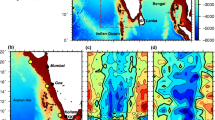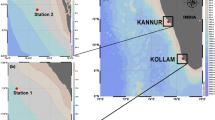Abstract
Two interdisciplinary cruises aimed at relating the ecology of marine fish populations to oceanographic conditions were fielded during the late summer and late winter seasons near Palmyra Atoll (5.9°N, 162.1°W) in the Line Islands. Ocean current and hydrographic measurements revealed interaction of the flow with the steep topography. During the first cruise (August/September 1990) satellite-tracked surface drifters and acoustic Doppler current profiler (ADCP) measurements showed a strong eastward setting North Equatorial Counter Current (NECC) with maximum speeds exceeding 1 m s−1 at 80 m depth approximately. This current turned southeastward on closer approach to Palmyra. The drifter paths exhibited excursions with zonal wavelength of approximately 250 km, meridional amplitude of 25 km and period of approximately 5 days. During the second cruise (February/March 1992), the ADCP-derived speeds of the NECC were weaker (maxima approximately 33 cm s−1) while the relative geostrophic flow component was of magnitude similar to 1990 and the signal of zonal geostrophic currents reached much deeper to approximately 650 m depth (150 m in 1990). Doming isopycnals beneath the surface mixed layer as well as thick (10–25 m) internal mixed layers were found near Palmyra during both cruises, with slightly different positions relative to the island. The discontinuous vertical temperature profiles may have been a result of strong boundary mixing due to breaking internal waves on Palmyra’s steep slopes. In the immediate vicinity of the island variations in flow speed, stratification and “mixing” in both the alongshore and cross-isobath directions were observed. Overall, the current speeds were reduced during February/March 1992, the peak time of the 1991–1993 warm event in the tropical Pacific. While parameters of turbulent two-dimensional wake theory are suggestive of formation and shedding of eddies in the lee of the island, no direct observations of circular motions were made in either expedition.
Similar content being viewed by others
Acknowledgements.
We thank the officer and crew of the NOAA vessel Townsend Cromwell for their support during this work, D. Cutchin and Judy Illeman of Scripps Institution of Oceanography for a near real-time meridional temperature section for NECC position and drifter positions, respectively. We also thank several colleagues at JIMAR (Joint Institute for Marine and Atmospheric Research): Jefrey Snyder for assistance in operating JIMAR’s AUTOSAL and E. Firing, S. Chiswell, G. Mitchum, R. Lukas, P. Flament, E. Stroup, K. Wyrtki and D. Moore for fruitful discussions. Finally, we thank Rusty Brainard and Scott Murakami at the Honolulu National Marine Fisheries Laboratory for data recovery and additional ADCP processing for the second cruise.
Author information
Authors and Affiliations
Corresponding author
Additional information
Responsible Editor: Hans Burchard
Rights and permissions
About this article
Cite this article
Hamann, I., Boehlert, G. & Wilson, C. Effects of steep topography on the flow and stratification near Palmyra Atoll. Ocean Dynamics 54, 460–473 (2004). https://doi.org/10.1007/s10236-004-0091-x
Received:
Accepted:
Issue Date:
DOI: https://doi.org/10.1007/s10236-004-0091-x




